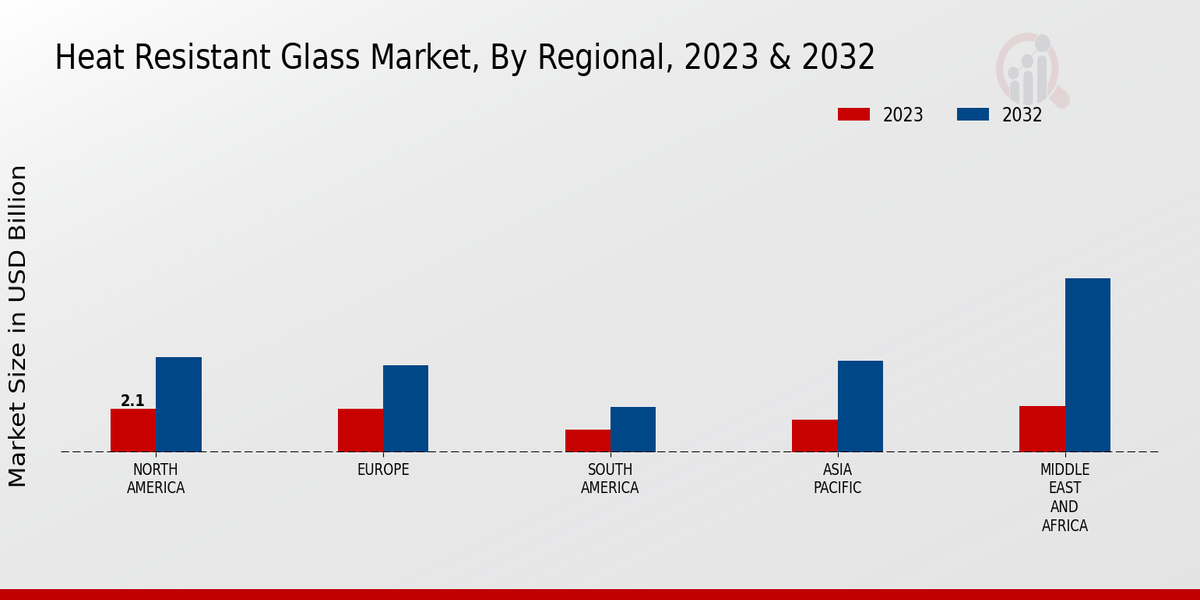Market Growth Projections
The Global Heat Resistant Glass Market Industry is projected to experience substantial growth over the next decade. With a market value anticipated to reach 24.5 USD Billion by 2035, the industry is on a trajectory of significant expansion. The compound annual growth rate (CAGR) of 11.94% from 2025 to 2035 indicates a robust market environment driven by various factors, including technological advancements, increasing demand in construction and automotive sectors, and regulatory support for sustainable materials. This growth presents opportunities for manufacturers and stakeholders to innovate and expand their product offerings, ensuring they remain competitive in a rapidly evolving market.
Expansion of Automotive Applications
The automotive sector is a key driver for the Global Heat Resistant Glass Market Industry, as manufacturers increasingly incorporate heat resistant glass in vehicle designs. This material is essential for components such as windshields and sunroofs, where high thermal resistance is necessary to ensure passenger safety and comfort. The automotive industry's shift towards electric vehicles further amplifies this demand, as these vehicles often require advanced materials to enhance performance and efficiency. As the market evolves, the integration of heat resistant glass in automotive applications is likely to contribute significantly to the industry's growth, reflecting broader trends in vehicle design and consumer preferences.
Rising Demand in Construction Sector
The Global Heat Resistant Glass Market Industry is experiencing a surge in demand driven by the construction sector. As urbanization accelerates, the need for durable and aesthetically pleasing building materials becomes paramount. Heat resistant glass is increasingly utilized in facades, windows, and interior applications due to its ability to withstand high temperatures and thermal shock. This trend is reflected in the projected market value of 7.08 USD Billion in 2024, with expectations to reach 24.5 USD Billion by 2035. The construction industry's growth, coupled with a CAGR of 11.94% from 2025 to 2035, suggests a robust future for heat resistant glass applications in modern architecture.
Growing Awareness of Energy Efficiency
The Global Heat Resistant Glass Market Industry is significantly influenced by the increasing awareness of energy efficiency among consumers and businesses. Heat resistant glass plays a crucial role in reducing energy consumption by minimizing heat transfer, thereby lowering cooling and heating costs. This growing emphasis on sustainability aligns with global initiatives aimed at reducing carbon footprints. As governments and organizations implement stricter energy regulations, the demand for energy-efficient building materials, including heat resistant glass, is expected to rise. This trend not only supports the market's growth but also encourages innovation in product development to meet evolving standards.
Regulatory Support for Sustainable Materials
Regulatory frameworks promoting the use of sustainable materials are shaping the Global Heat Resistant Glass Market Industry. Governments worldwide are increasingly enacting policies that encourage the adoption of environmentally friendly building materials, including heat resistant glass. These regulations often include incentives for using energy-efficient products, which can lead to cost savings for builders and homeowners. As a result, the market is poised for growth as stakeholders recognize the long-term benefits of investing in sustainable solutions. This regulatory support not only fosters innovation but also aligns with global sustainability goals, driving demand for heat resistant glass across various sectors.
Technological Advancements in Glass Manufacturing
Innovations in glass manufacturing technology are propelling the Global Heat Resistant Glass Market Industry forward. Advanced production techniques, such as the use of nanotechnology and improved tempering processes, enhance the performance characteristics of heat resistant glass. These advancements not only improve thermal resistance but also contribute to energy efficiency, making heat resistant glass an attractive option for energy-conscious consumers and builders. As a result, the market is likely to benefit from increased adoption across various sectors, including automotive and electronics, where high-performance materials are essential. The ongoing evolution in manufacturing processes indicates a promising trajectory for the industry.





















